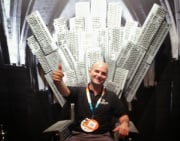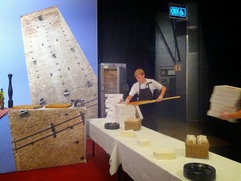

JavaZone
is winding down as I’m starting to write this although I’ll probably post this after the videos are up to reference some of the interesting sessions I saw. Unfortunately JavaZone doesn’t post workshop videos so my workshop won’t be available, but frankly it wouldn’t have worked well in video since it was relatively interactive hence there was no presentation flow. You can see the gist of the workshop in the video I posted
a couple of weeks ago
. The next few paragraphs are about JavaZone itself and the trip, if you want to read about the session highlights just scroll down…
On the right you can see a picture of me on the
“Game Of Code”
throne, its hard to make out the details with my awful Nexus camera but these are actually quite a few real keyboards dyed in silver that are used to form a chair.
JavaZone started for me with the great
speakers dinner, got to meet lots of great guys and eat some of the great JavaZone fair which deserves a paragraph of its own…

The real star of JavaZone is the food though, its hard to say this but I finally think JavaZone broke me… There was literally too much and it was all good. I totally pigged out!
JavaZone doesn’t have meals it has continuous food integration (or continuous delivery, frankly it felt like a waterfall). This effectively means that there are no lunches/dinners. Food starts pouring out around 10 and just doesn’t stop until 4-6pm, so you can just walk around all day picking something here and there whenever you feel like it. Just to give you a sense of the available foods:
Pizza, freshly made check out the photo. Some people say that there is no such a thing as bad pizza, I strongly disagree. But this was good pizza which is pretty amazing for conference fair.
Other than that:
Sushi, Burgers, Sausages (in bun), Tacos with choice of meats, Cababs with lafas (type of pita), Indian style curries and rice, local foods (shrimps, mushrooms, potatoes), ice cream bar, soft serve icecream, mini-cupcakes, smoothy stand, juice bar, a molecular cuisine stand that made things like foie gra with carbonated nuts and fresh ice cream from liquid nitrogen!
Amazingly I’m sure I’m missing quite a lot as I’m writing all this from memory!

The guys and gals running the show are all pretty cool people as is evidence by all of the above, unfortunately this year there was no new JavaZone t-shirt (although they gave a great waterbottle which my spouse immediately confiscated for her own use) so I stopped by their booth and they gave me this t-shirt.
That shirt is amazingly cooler than the one they we
re wearing themselves, no wonder they kept it hidden!
The party and trip after the conference are also cool things but I couldn’t go on the trip and was so exhausted I barely functioned at the party. Although it was at a great club and the band was good.
That shirt is amazingly cooler than the one they we
re wearing themselves, no wonder they kept it hidden!
The party and trip after the conference are also cool things but I couldn’t go on the trip and was so exhausted I barely functioned at the party. Although it was at a great club and the band was good.
The Sessions
There were many great sessions and speakers this year, I can’t possibly cover everything and I was running around so much I barely had time to see it all (despite the overflow room which is the greatest concept in any Java conference!).
You can check out the videos of all the sessions here:
Here are the ones I went to mostly in order of appearance:
You can check out the videos of all the sessions here:
Here are the ones I went to mostly in order of appearance:
|
Cliff Click (great name for the tech industry) gave on the first talks in the conference: ”
Building A Big Data Machine Learning Platform “. I was highly conflicted between this and the Docker talk and eventually picked this talk. Normally its less of a subject I care about since we have our big data App Engine backend but the talk was really interesting, the way in which the data is held in memory and partitioned across devices/VM’s is fascinating. Normally I thought in-memory DB’s were limited by machine RAM and it seems this is untrue. |
|
|
Neal Ford had a talk titled ”
Continuous Delivery for Architects “. His talk was great and very complimentary to the talk given by his colleague Sam Newman later on. His presentation visualizes a lot of the complexities of dealing with hugely complex architectures, which is something I don’t really run into as much so while it was very interesting it was mostly on an academic level. I did enjoy this presentation tremendously as a guide for “how to present a highly technical set of ideas visually”. I’m a less visual person by my nature so these presentations help me present in a way other people understand. Neal has a new presentation book with Nathaniel Schutta and Matthew McCullough. All 3 are amazing speakers with remarkably different speaking techniques which makes the collaboration very interesting… I just bought the Kindle version and have started reading thru it (reading slowly since I’m too busy preparing for JavaOne will probably have some time on my trips to the states/India). The premise of the book is very strong and it was probably a bad idea to pick it up just before I have to give a presentation (at JavaOne) since its really making me want to fix some things about it… I’ll post a more detailed book review later but I can already recommend buying it. |
|
|
Sam Newman practically had me rolling on the floor laughing at ”
Practical Considerations For Microservice Architectures “, over his joke in the first few minutes (maybe its the dry British humor I like so much). I’m still conflicted about how practical it is for our type of organization to adopt such an architecture, but as we grow up this does seem like a reasonable approach. |
|
|
I missed most of the talk ”
50 new features of Java EE 7 ” from Arun Gupta and only got the end of it, that’s OK because I’ll probably be able to check the full thing at JavaOne. I’m checking out the full talk on Vimeo right now just in case JavaOne has bad scheduling (JavaZone is so great in that regard). Check out the talk to learn about Java EE 7 or better yet check out his book on Java EE 7 . |
|
|
Probably the highlight of the show was
Kent Beck . If you don’t know who that is then go to your library, hopefully “Design Patterns” is there… When you have a chance to listen to someone who had such an impact on the industry give a talk you should take it no matter what the subject is and I was quite happy I did. The talk was a bit too high level dealing with design as an overly abstract word, but his basic axioms were non-religious about the position of design and a lot of his insights were spot on and enlightening. |
|
|
Ken Sipe gave a talk titled ”
Future of Development and the Cloud ” where he talked about mesos , which I haven’t heard about before and mostly came because the session had Docker in the abstract. I’m blissfully unaware of some of the complexity involved in this field thanks to Google App Engine (or because of?), so some of this went right over my head. Still the talk was interesting and it gave me a lot to think about regarding our future directions. |
|
|
Nathaniel Schutta is someone you should see talk, he gives these fluid hilarious presentations that are always fun to watch even if you disagree. He makes the talk seem effortless which it might be with that level of experience. His talk this year was titled ”
Mind the Gap: Architecting UIs in the Era of Diverse Devices ” and had talked about the difficulty of dealing with all these devices. Wisely Nate doesn’t leave time for Q&A but that was not something I was willing to accept so I grabbed him immediately after for a long hard talk about Codename One and getting rid of his JavaScript obsession. I don’t think his armor is cracked but judging from the obvious pain and suffering that shows thru his presentation he has no choice but to pickup Codename One eventually. (Check out the new book he published with Neal Ford & Matthew McCullough, see above) |
|
|
Rafael Wintherhalter gave a talk titled:
Understanding Java byte code. He is the author of ByteBuddy which I didn’t know of prior to this, it seems like a really cool tool with great syntax. Unfortunately it seems to be designed for server use which is less applicable for our very unique use cases. The talk is a pretty great introduction to the Java VM bytecode, for me the talk was a bit too basic since this is something I’ve been deep into for years. However, he explains the subject with great slides and examples so that video is going right into my bookmarks when training new recruits on the inner workings of our VM code and getting them up to speed on bytecode! If you don’t know those things you should watch that talk to understand what Java does underneath the hood. |
|
|
Jim Webber had a couple of interesting talks including a full day workshop on day 1 which was too much for me. Especially given that we already have a database architecture and the thought of replacing it is just too painful. But Neo4j is pretty interesting and querying complex graph DB’s really brings up the hacker in me, hes a pretty talented, fluid speaker with a great sense of humor in his presentation (maybe its the dry British humor that I liked). So I really enjoyed his talk
A Little Graph Theory for the Busy Developer . |
|
|
Handling complexity through configurability: Erex – an energy settlement solution for the railways of tomorrow . I met Gareth in the Speakers dinner and decided to checkout his talk, its pretty relevant to me as well since I have a success story style session pending for JavaOne and its always interesting to see how someone else handles this sort of session. Gareth & Ragnar did well trying to convey some of the complexity of a huge project with a lot of inherited decisions that just can’t be changed, this is hugely challenging when conveying something like this to an outside audience. I think they had some good ideas on how the scale can be conveyed via slides & UML zoom out. |
|
|
The only downside of going to the session above was the fact that I couldn’t attend Brian McCallister’s session:
I-Tier: Breaking Up the Monolith . I did check it online in Vimeo later (great thing about JavaZone) and its really interesting. We’re coming from the opposite side of a cloud architecture that is trying to normalize whereis Groupon has a far different approach. I’m not a fan of the node.js architecture but its interesting hearing real world experiences with modularity which is something we all need. |
|
Notice: This post was automatically converted using a script from an older blogging system. Some elements might not have come out as intended…. If that is the case please let us know via the comments section below.





1 Comment
I know I said the same thing last year, but thank you for your trip report. It’s really nice to have that kind of feedback about these big events!